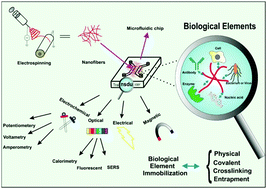Pivotal role of electrospun nanofibers in microfluidic diagnostic systems – a review
Abstract
Recently, the usage of electrospinning technology for the fabrication of fine fibers with a good deal of variation in morphology and structure has drawn the attention of many researchers around the world. These fibers have found their way in the many fields of science including medical diagnosis, tissue engineering, drug delivery, replica molding, solar cells, catalysts, energy conversion and storage, physical and chemical sensors and other applications. Among all applications, biosensing with the aim of rapid and sensitive biomarker detection is an area that warrants attention. Electrospun nanofibrous membranes enjoy numerous factors which benefit them to be used as potential candidates in biosensing platforms. Some of these factors include a high surface to volume ratio, analogous scale compared to bioactive molecules and relatively defect-free properties of nanofibers (NFs). In this review, we focused on the recent advances in electrospun nanofibrous membrane-based micro-analytical devices with an application as diagnostic systems. Hence, a study on the electrospun nanofiber usage in lab-on-a-chip and paper-based point-of-care devices, with an opening introduction to biosensors, nanofibers, the electrospinning method, and microfluidics as the principles of the intended subject, is provided. It is anticipated that the given examples in this paper will provide sufficient evidence for the potential of electrospun NFs for being used as a substrate in the commercial fabrication of highly sensitive and selective biosensors.

- This article is part of the themed collection: Recent Review Articles


 Please wait while we load your content...
Please wait while we load your content...